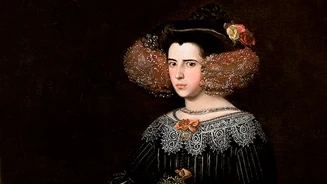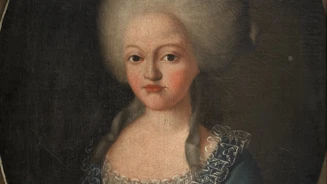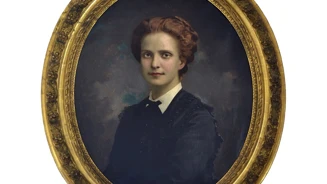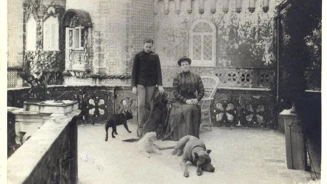Female power: 10 queens who left their mark on Sintra
17 Jul 2025
Did you know that Sintra was not only a stage for kings and great men of the court? Many women in the history of Portugal left their mark here too. Some ruled from the “wings”, beside their kings, while others took the reins of the country themselves. Of the ten queens we present here, all have one thing in common: this magical setting, Sintra.
The Queen’s Household: much more than a title
Let’s start from the beginning. For centuries, Portugal had an official institution dedicated to its queens: the ‘Casa das Rainhas’ – or Queens’ Household. It was not a “house” in the ordinary sense, but a genuine institution with its own income, drawn from rents, taxes and other assets. So, rather than being mere “ornamental figures”, these queens managed these lands, taking on a role of significant responsibility and achieving, at the same time, a remarkable degree of independence. Sintra formed part of the Queen’s Household from the 13th century until its extinction. A little-known but very real source of power — discover more about this feminine side of Portugal’s history.

The history of Sintra’s palaces is intertwined, at different times, with the life stories of these queens. Let’s get to know some of them.
Isabel of Aragon, the Holy Queen that had Sintra worship the Holy Spirit
She married King Dinis in 1282 and received the Castle of Sintra as part of her dowry. By 1287, she was lady of the town. Known for her deep piety and concern for the poor, it’s believed she introduced the Cult of the Holy Spirit to Sintra – the very same to whom the chapel of the National Palace of Sintra is dedicated. Even today, this feast is still celebrated in parts of the municipality with great pomp and ceremony!
Leonor Teles, the most powerful:
As the consort of King Fernando I, Queen Leonor held vast domains, including Sintra, over which she wielded almost total authority. She appointed officials and governed in the king’s name. After his death in 1383, she became regent for her daughter, Beatriz, who was engaged to the King of Castile. Chronicles of the time say the people of Sintra remained loyal to Queen Leonor – in 1384, the Master of Avis, king Fernando I’s illegitimate brother and a rival to Beatriz and D. Juan I, confiscated property from Sintra residents who didn’t support him. She wasn’t just in control – she had the people’s support. Of all the medieval queens, Leonor Teles held the most power in Sintra.
Philippa of Lancaster, a very British queen in Sintra:
An Englishwoman through and through, who struggled to adapt to the Portuguese court — that is perhaps the best way to describe the wife of King João I, one of the queens who ‘took charge’ of Sintra. To this day, her presence can still be felt at the National Palace of Sintra. Contrary to popular tales that have spread around Sintra over time, the magpies painted on the ceiling of the Magpie Room have nothing to do with romantic escapades or local gossip. In fact, the true meaning of the 136 magpies adorning this room remains uncertain, but the roses clutched in the birds’ claws likely allude to the English House of Lancaster, to which Queen Philippa of Lancaster belonged. “Por bem” (“For the good”) was the motto of her husband, King João I. The story could have been far juicier — but it is, in all likelihood, as simple as that.
She preferred to leave the governance of Sintra to her officials, yet her strong character and strict habits — she observed fasts and long periods of abstinence — proved that Philippa of Lancaster had the resolve to take an active role in diplomacy. She played a decisive part in strengthening the alliance between Portugal and England, her homeland and the land of her heart — which, even if only in spirit, she never truly left behind.

Catherine of Austria and the “serejas de Simtra”:
During her regency while her grandson, King Sebastião, was still a minor, Catherine of Austria found in Sintra a kind of retreat. The Palace of Sintra in fact became one of King Sebastião’s favourite residences, where he spent long periods of time. Catherine of Austria was also responsible for founding the ‘Santa Casa da Misericórdia!, whose church and hospital stood opposite the Palace of Sintra.
A curious detail: besides her fondness for Sintra and the Royal Palace, the queen had an even greater fondness for the local delicacies. A household accounts book from 1571 reveals what was served at the queen’s table and to her ladies-in-waiting — notably the “serejas de Simtra” (cherries from Sintra). Other records show that the queen received scented rose and flower water, as well as pots of honey, as payment for the lease of her lands in Sintra. One could say she was a queen with a taste for Sintra’s sweeter side.
Luisa de Guzmán – make way for the queen!:
The wife of King João IV took on governmental responsibilities on numerous occasions, especially during the king’s absences, and remained politically active even after his death. As queen, she retained all the property belonging to the Queen’s Household and, together with the monarch, established a dedicated institution to manage these assets: the ‘Casa e Estado das Rainhas’. Sintra was the first of her estates to be visited. And what a visit it was! A record of her stay in July 1652 shows how every detail was carried out with great pomp and ceremony: every road leading to and from Sintra had to be properly decorated to mark the Queen’s passage; if necessary, the town council was to summon masons and quarrymen who, with pickaxes, would break through rocks and remove any obstacle blocking the royal procession; the people of every parish were required to be present to see the Queen pass by — and the young women of Colares, in particular, were expected to bring baskets of the finest fruit to offer the sovereign.
But it wasn’t all pageantry: Luisa de Guzmán took a direct role in Sintra’s affairs, appointing and honouring local officials, including women — something remarkably rare for the time.

Maria I, mad for Queluz:
She was the first woman to rule Portugal in her own right and the first queen to take up residence in the Magpie Room at the National Palace of Sintra — a room traditionally reserved for kings. Yet, she always preferred the Palace of Queluz, which, at the time, became the official residence of the Royal Family. As can be seen in the letters she exchanged with her daughter, Maria I loved spending time in the gardens of Queluz and its surroundings: “(...) I have been taking my rides in the estate on horseback and beyond it, to Belas. I have been there twice. On St Lawrence’s Day we had jousting here (...) The costumes were beautiful and well made. Afterwards, there were bulls, but they were poor because they were tame, as were the bullfighters, including Ramires, whom you know. This was all organised on Carlota [Joaquina]’s account. She said she didn’t care much for the bulls, which is not typical of the nation. The illumination could not take place because of the winds we have had,” she wrote in a letter dated August 1785. In another, from 1786, she described the lovely flowers she enjoyed in the palace gardens: “We have always had plenty of flowers at Queluz and we went to put them in the vases, which looked beautiful, although the day brought showers in the morning, but since then the weather has been fine.” Those were happy times spent at Queluz, but she would eventually have to abandon her beloved palace. She became the first European monarch to set foot in the Americas, when the Portuguese court was transferred to Brazil during the French invasions — at that point, Rio de Janeiro became the capital of the United Kingdom of Portugal, Brazil and the Algarves.
Carlota Joaquina, from ‘spoilt’ princess to the ‘shrew’ of Queluz:
Born in Madrid, she was just ten years old when she married Infante João, son of Maria I, Queen of Portugal. Upon arriving in Portugal, she spent much of her time at Queluz. Reading letters sent by Prince João to his sister, it is clear that Carlota was quite fond of Queluz: “We went to Queluz the day before yesterday. The Infanta [Carlota] liked it very much and told me this palace has no end.” But the truth is she was a… challenging child: “I cannot fail to tell Your Highness that these days Her Highness [Carlota] has been most impertinent, very rude in her manners, and has done her lessons very poorly, especially Father Felipe’s (…) Also, on Saturday, while lunching with the Infante [João], she took a piece of sole and threw it at a maid who was serving at table. Part of it hit the face of the Infante himself, which he did not like at all, although Her Highness excused herself saying she had not done it on purpose (…)” wrote her governess, Miquelina, in a letter sent to the Princess of Asturias, Carlota Joaquina’s mother, in 1785.
One might think she was a true fairytale princess, with her peculiar moods and stubborn whims: “Madam, yesterday and today Her Highness [Carlota] has been very obstinate, refusing to do anything she is told (…) This morning, to put on her shoes, her corset and to take her chocolate, she took from eight until ten o’clock, and the more she was urged to hurry, the more silent and slower she became. When she finally had her chocolate, Infanta Dona Mariana was present, and this morning she said that never in all her life had she seen anyone take so long to drink chocolate, for she took three-quarters of an hour,” her governess reports in another letter.
Carlota Joaquina had nine children, six of whom were born at the Palace of Queluz, including King Pedro IV. She was not just a devoted mother but also fiercely ambitious, even conspiring against her husband. Later, she attempted to establish a new kingdom in South America, though without success. With the Liberal Revolution, she refused to swear the Constitution of 1822 and supported her son Miguel in his struggle against the liberals. Her schemes failed, and she was eventually removed from court.
It is true she became known as the “Shrew of Queluz”, a nickname given by the liberals, but she was also seen as a heroine by the absolutists. In the end, she died at Queluz — the palace that saw her grow up and witnessed the many ups and downs of one of the strongest women in Portuguese monarchy.

Maria II, the inspiration behind the Pena Palace:
The reign of Queen Maria II was far from easy: from the September Revolution to the reform of the Constitutional Charter, much unfolded in Portugal during her years on the throne. She could not simply be a decorative figure — she was a strong woman who rolled up her sleeves and governed the country through one of the most turbulent periods in its history. Her escape? Her family. Married since 1836 to Ferdinand of Saxe-Coburg and Gotha, Maria cherished family moments with her husband and children. So much so that, just two years after their wedding, Ferdinand decided to give shape to a dream: to build, with his own resources, a haven for his family. And so the Pena Palace was born — the ultimate romantic retreat, shaped by his love for Maria II and the family they built together.
Maria II was a constant presence at the palace while it was under construction, even having provisional chambers in the old monastery core. Accompanied by her husband, she closely followed the progress of the works. Together they walked the unfinished corridors alongside Baron von Eschwege, the architect behind the project, as chronicled by Félix Lichnowsky in an 1842 account. By then, four years into the construction, the palace already had habitable rooms decorated to the royal couple’s taste: “The rooms, according to Their Majesties’ wishes, were adorned with great simplicity; yet they contain a great number of those old furnishings in which Portugal is so rich (…)” The creation and planting of the park was another shared passion. A letter written by the Queen in French shows how dedicated she was to every detail: together with the gardener Bonnard, she arranged for 84 camellia plants to be sent for planting at the palace, including all those from the terrace of the Palace of Necessidades, in Lisbon.
The ‘Folhas da Despeza na Real Obra e Quinta da Penna’ record expenses for various luncheons enjoyed by Maria II, her husband, their children and entourage. These family occasions are mentioned by José Trazimundo Mascarenhas Barreto, Marquis of Fronteira and d’Alorna, in his ‘Memoirs’, where he highlights the warm, domestic atmosphere: “The Kings, like all of us, like to live as a family; the Queen enjoyed this, like a good mother, and in the delightful Pena, in Cintra, surrounded by her own, she would host picnics or dinners.”
The Palace of Pena was conceived as Maria II’s refuge, yet the Queen died before its completion and never saw her dream residence finished. What remains is the symbol of a great love story — one we can all visit today.

Maria Pia of Savoy, the last resident of the National Palace of Sintra:
She arrived in Lisbon on 5 October 1862, never imagining that 48 years later, on that same date, the monarchy would give way to the Republic and she would be forced to flee Portugal. The wife of King Luís I stood out for her determined character and remarkable sense of duty. In the biography ‘Queens Loved by the People’, historian and university professor Maria Antónia Lopes portrays her as an intelligent, generous, bold and regal figure, shedding light on the queen’s discreet diplomatic role during the reign of King Carlos — a contribution largely overlooked until now. But on 5 October 1910, her life took an unexpected turn: Maria Pia was at the Palace of Sintra when the monarchy fell. It was from there that she fled to Ericeira, from where she departed with her daughter-in-law and grandson into exile. She was the last monarch to go about her daily life in the National Palace of Sintra, bringing life to its memory-filled rooms and to the palace that had once welcomed the kings and queens of the past.

Amelia of Orléans, the last resident of the Palace of Pena:
The wife of King Carlos, Amelia held a deep affection for the Park and Palace of Pena. She often spent long periods there, enjoying the surrounding nature, basking in the sun on the terrace and taking advantage of Sintra’s mild climate. On 3 October 1910, King Manuel II warned his mother, Amelia, of the growing unrest in the country. The queen mother immediately realised she could not remain in Sintra for much longer. And so, on the morning of 5 October, Amelia and Queen Maria Pia left the Palace of Pena and the National Palace of Sintra respectively, heading to Ericeira where they joined the king. It was the last time members of the royal family lived in these palaces. That same day, the Republic was proclaimed in Portugal. With this turn of events, Amelia of Orléans went down in history as the last queen consort before the fall of the monarchy and the final monarch to live in the jewel of the Sintra hills.

